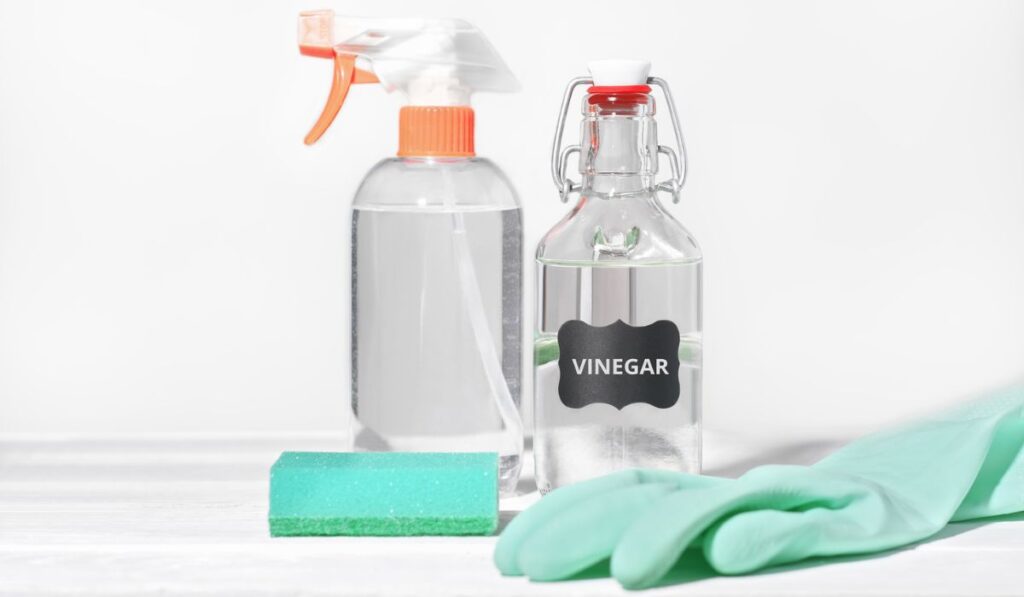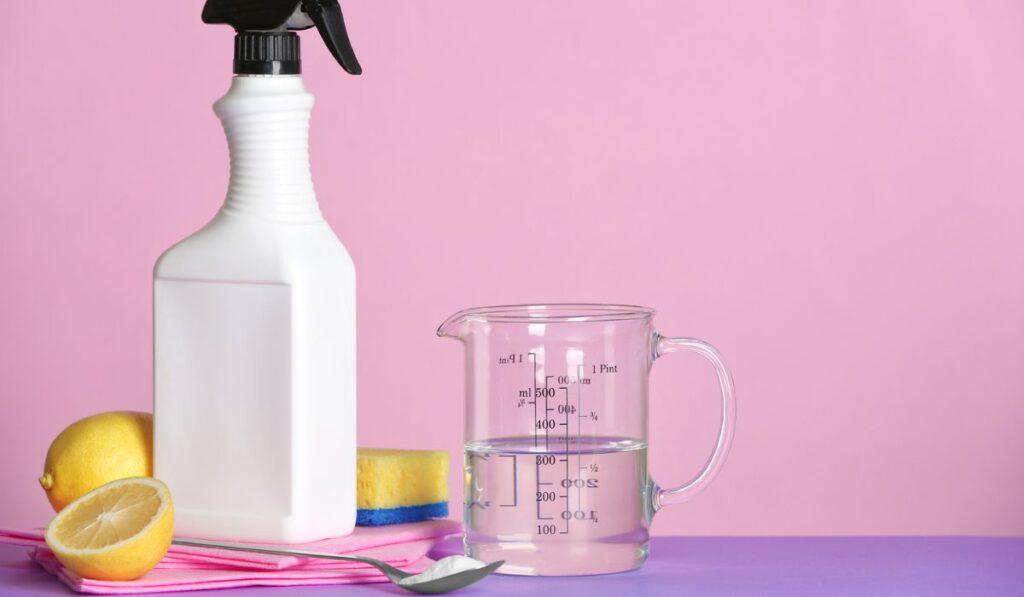We all love a clean bathroom, but keeping your bathroom spotless is easier said than done. Some experts recommend using a tool that you’ve probably already got in your pantry: vinegar. Vinegar has been used as a surface cleaner for ages, but just how effective is it for cleaning a bathroom?
Vinegar is a safe, natural cleaner with high acidity, making it ideal for cleaning the bathroom. Vinegar cuts grease, deodorizes, and disinfects surfaces. Diluted vinegar is safe for most surfaces, but avoid using it on porous areas. Vinegar can also be used with water, lemon, and dish soap.
If you’re on a budget and looking for natural cleaners to keep your home clean, vinegar may be exactly what you need. Let’s take a closer look at how vinegar can be used to clean a bathroom, how to create the perfect cleaner with vinegar, and what you shouldn’t try to clean with vinegar.
Is Cleaning a Bathroom With Vinegar Effective?

Vinegar is known as the “wonder cleaner,” and it’s great for cleaning bathrooms. You can use vinegar to clean shower heads, toilets, bathroom floors, shower doors, and even faucets.
Vinegar helps loosen grime and dirt, remove grease, and neutralize bad odors.
The high acidity in white vinegar reacts with stains on most surfaces and breaks down organic matter. This helps loosen the dirt, allowing you to easily clean even the toughest stains.
For this reason, most household cleaning chemicals have some type of acid that actively helps break down dirt from surfaces.
Vinegar can also be used to clean grout in bathroom tiles. If you’ve tried cleaning grout with a regular floor cleaner, you’ll know how difficult it can be to clean. However, vinegar works wonders on grout and other surfaces where regular cleaners usually don’t have any effect.
Which Type of Vinegar Is Best for Cleaning?
While apple cider or balsamic vinegar may taste great in a meal, white vinegar is the more effective option for cleaning.
A normal white vinegar (on Amazon) is suitable, or you can look for a special cleaning vinegar (on Amazon) that has a higher acid concentration.
The special cleaning vinegar may be more effective in removing very difficult stains. However, don’t use it on any surface except the toilet, as it’s so strong that it could cause damage.
Undiluted vinegar can be just as effective as bleach since it also has disinfectant properties. However, it’s much gentler than bleach and won’t damage most bathroom surfaces.
That said, keep in mind that the EPA doesn’t consider vinegar-water solutions to be sanitizers or disinfectants.
How to Clean a Toilet With Vinegar
To clean a toilet with vinegar, simply pour one cup of vinegar into the toilet bowl and leave it overnight. Then scrub your toilet with a brush and flush the vinegar away. This will leave you with a shiny, spotless toilet bowl.
To get to those pesky spots under the rim of the toilet, you can soak some paper towels in vinegar and tuck them in there. After a few hours, remove the paper towels and wipe the toilet clean.
What to Mix With Vinegar for a Better Clean

The best thing to mix with vinegar for cleaning is water. It’s surprisingly effective but also gentle enough that it won’t damage most surfaces. Most people find a one-to-one ratio of vinegar to water to be the perfect amount, especially with warm water.
Avoid diluting the vinegar too much, or it may hamper its effectiveness at removing tough stains.
However, if you’re looking for something a little stronger, mix vinegar with dish soap. Add a few drops of dish soap to vinegar in an empty spray bottle and get to work. You’ll get those surfaces squeaky clean!
Lemon also has a similar cleaning effect, and when mixed with vinegar, it gives the added bonus of producing a nice natural smell while canceling out the acidic smell of the vinegar.
Fill an empty spray bottle with one tablespoon of white vinegar and two tablespoons of lemon juice, and you’ll be able to clean most stains.
Alternatively, you can add essential oils to get a better odor when cleaning the bathroom with vinegar. Add a few drops of your favorite essential oils to the vinegar solution. This combination will mask the vinegary scent and give a more pleasant aroma to your home.
However, never mix vinegar with hydrogen peroxide or bleach, as these mixtures will create toxic fumes that may affect your breathing. Also, avoid mixing vinegar with other acid-based cleaners, as it can result in adverse reactions that may cause more harm than good.
Do You Need to Rinse After Cleaning With Vinegar?
You might need to rinse some surfaces after cleaning with vinegar, especially if they’re porous, such as wood, granite, and marble. It’s best to develop a habit of rinsing these surfaces off after using vinegar, to be safe.
However, for surfaces such as glass, you only need to wipe the vinegar off after cleaning, and you’re good to go.
When cleaning with vinegar, always keep in mind that while it’s not toxic, it’s still acidic, and it can be harmful to your skin. Make sure to wear protective equipment like gloves (on Amazon).
What Not to Clean With Vinegar
Vinegar is a great cleaner, but it shouldn’t be used for everything. Avoid using vinegar on the following surfaces:
- Hardwood Floors: Vinegar can dull the shine of hardwood floors over time and affect their coating.
- Electronic Screens: Vinegar can remove the protective coating and damage electric screens. Never try to use it on your laptop or TV screen!
- Metal: Vinegar has the ability to corrode metals and can dull knife edges.
- Rubber: Vinegar can eat away at certain chemicals found in rubber, so avoid using it on rubber surfaces.
- Natural Stone: Natural stones like granite, marble, and quartz become dull and lose their shine when exposed to the acid in vinegar.
